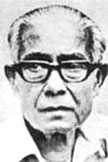Nihar Ranjan Gupta
| Nihar Ranjan Gupta নীহাররঞ্জন গুপ্ত | |
|---|---|
 Nihar Ranjan Gupta | |
| Born |
6 June 1911 Jessore, Bengal, British India |
| Died |
20 February 1986 (aged 74) Kolkata, West Bengal, India |
| Nationality | Indian |
| Occupation | Physician, Novelist |
| Religion | Hinduism |
| Parents |
Satya Ranjan Gupta Labangalata Devi |
Dr. Nihar Ranjan Gupta (Bengali: নীহাররঞ্জন গুপ্ত) (6 June 1911 - 20 February 1986) was an Indian dermatologist and a popular Bengali novelist. He is the creator of the fictional detective character Kiriti Roy.[1][2][3]
Early life
Gupta came from a prestigious Kabiraj family of Itna village under Lohagara police station, in the district of Jessore, presently in the Narail district of Bangladesh. He was born to Satya Ranjan Gupta and Labangalata Devi on 6 June 1911, in Kolkata where his father used to work. He spent his childhood in Kolkata. Due to his father's transferable job, he had to attend several schools, including Gaibandha High School.[3] In 1930 he passed Matriculation from Konnagar High School.[3] After completing his I.Sc. from Krishnanagar College, he took admission to Carmichael Medical College.[3] While a student at the college, his elder sister died of scorpion bite. Young Gupta vowed to earn higher degree in the medical sciences in order to serve the ill.
Career
During the Second World War, Gupta served as an army doctor and was posted in different parts of the world. He was posted in Chittagong, Burma and Egypt.[1] After the war, he completed post-graduation in medicine from the United Kingdom, specializing in dermatology. On his return he joined the Calcutta Medical College. In his career as a physician he was associated with several hospitals in India.[1] After the Partition, his family permanently migrated to Kolkata in 1947.[4]
As a child Gupta always dreamed of becoming a writer. He once went to Shantiniketan to seek the blessings of Rabindranath Tagore and took his autograph.[2] At the age of eighteen he composed his first novel, Rajkumar. After schooling, Gupta took admission in the Calcutta Medical College, then affiliated with the University of Calcutta. During his stay in England he developed a keen interest in detective stories and met Agatha Christie.[2] After coming back to India, he composed his first detective novel, Kalo Bhramar [কালো ভ্রমর] where his launched his detective character Kiriti Roy [কিরীটী রায়]. In his literary career Gupta has composed over two hundred novels, plays, short stories and essays. The most popular among them are Ulka, Badshah, Lalubhulu, Uttarphalguni, Asti Bhagirathi Tire, Mayur Mahal, Devyani, Neeltara, Mayamriga, Komalgandhar and Nishipadma. Forty five of his novels have been made into Bengali and Hindi feature films in Tollywood and Bollywood respectively.[5] He was also the editor of a children's magazine named Sabuj Sahitya.[1][2]
Legacy
In 1988, S.M. Sultan founded the Shishuswarga-2 at the ancestral house of Gupta in Itna. It was officially inaugurated on 24 November 1993, by the Mohammad Ali Hossain, the then District Magistrate of Narail. However, the activities of the children's organization ceased after the death of S.M.Sultan. In 2003, the archeological department of Bangladesh notified the acquisition of Gupta's ancestral house, but has not made any repairs till date. At present the ancestral house of Nihar Ranjan Gupta lies in a dilapidated condition, infested by bats and illegal betting syndicates.[4]
Adapted works
- Meri Surat Teri Ankhen (1963) - Ulka [6]
- Uttar Falguni (1963), Mamta (1966), directed by Asit Sen, both starring Suchitra Sen as the lead. [7]
- Do Anjane (1976) - Ratrir Yatri [8]
References
- ↑ 1.0 1.1 1.2 1.3 Sengupta, Subhodh Chandra; Basu, Anjali, eds. (January 2002). "নীহাররঞ্জন গুপ্ত" [Nihar Ranjan Gupta]. Samsad Bangali Charitabhidhan (Bibliographical Dictionary) (in Bengali). Volume 2 (4th edition ed.). Kolkata: Shishu Sahitya Samsad. p. 168. ISBN 81-85626-65-0.
- ↑ 2.0 2.1 2.2 2.3 "Kolkatar Kadcha". Anandabazar Patrika. June 27, 2011. p. 4.
- ↑ 3.0 3.1 3.2 3.3 Bipul, Mohammad Hasanuzzaman; Shanta, Samiul Amin. "নীহার রঞ্জন গুপ্ত". Jessore.Info. Retrieved September 10, 2011.
- ↑ 4.0 4.1 "নড়াইলে সুলতানের শিশুস্বর্গ এখন জুয়াড়িদের আখড়া". News Bangla 24. September 3, 2010. Retrieved September 10, 2011.
- ↑ "Nihar Ranjan Gupta’s birth anniversary observed". The Daily Star. June 8, 2009. Retrieved September 10, 2011.
- ↑ "Meri Surat Teri Ankhen (1963)". The Hindu. Retrieved Apr 29, 2013.
- ↑ "Blast From The Past: Mamta (1966)". The Hindu. Apr 02, 2010. Retrieved April 29, 2013.
- ↑ "Rekha breaks her silence". The Hindu. October 8, 2010. Retrieved Apr 29, 2013.